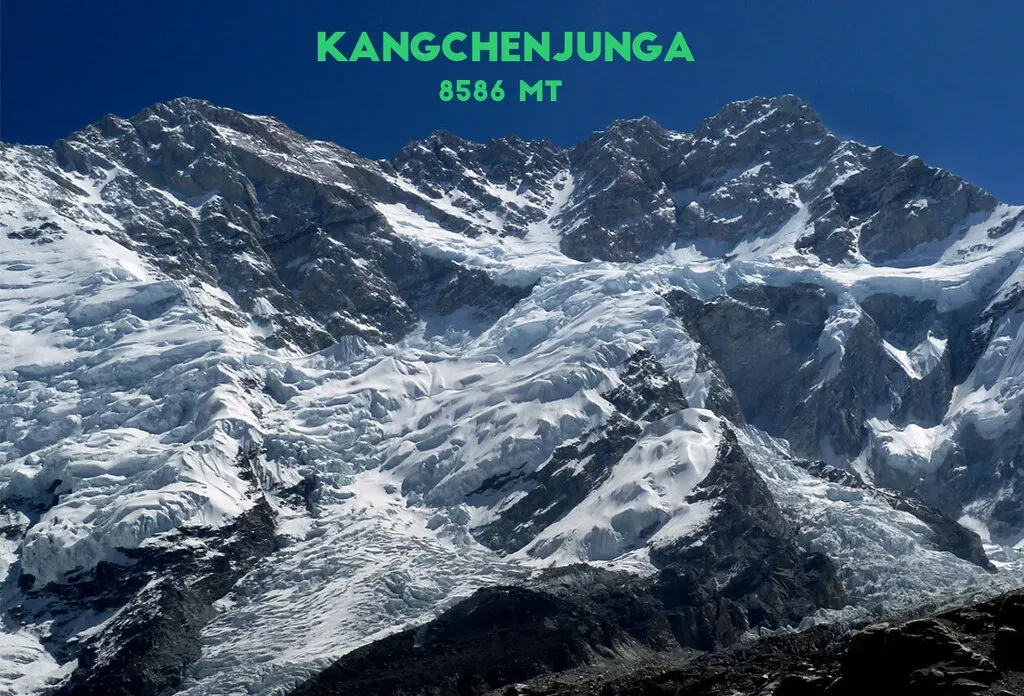The ascent of Kangchenjunga is a formidable challenge that beckons climbers from around the globe, but it comes with its share of dangers. This stunning peak, standing at 8,586 meters, is located on the border of Nepal and India and ranks as the third highest mountain in the world. Quebec climber Marie-Pier Desharnais faced the ultimate test of her determination and resilience when she summited Kangchenjunga on May 18, 2023. The risks of mountain climbing safety were starkly highlighted when Desharnais encountered the tragic aftermath of a fellow climber’s fatal struggle with altitude sickness just before her own summit attempt. As she reached the pinnacle, the harsh realities of death and the relentless pursuit of adventure collided, forever altering her perspective on climbing and life itself.
Reaching the peak of Kangchenjunga represents not just a personal triumph, but also a deep dive into the realities of high-altitude mountain climbing. This awe-inspiring summit, known for its breathtaking views and treacherous paths, presents climbers with extreme challenges, from unpredictable weather to the serious threat of altitude sickness. The journey to conquer this majestic peak can become a poignant experience, as demonstrated by the harrowing ascent faced by Quebec’s Marie-Pier Desharnais. She not only battled the mountain’s physical demands but also grappled with the emotional weight of witnessing a tragic incident among fellow adventurers. Such eye-opening experiences underscore the critical importance of mountain climbing safety and emphasize the realities that climbers must confront in their pursuit of summiting the world’s great heights.
The Harsh Realities of Kangchenjunga Ascent
The ascent of Kangchenjunga is no ordinary feat, often regarded as one of the most perilous climbs among the Himalayas. For Quebec climber Marie-Pier Desharnais, the climb not only challenged her physical endurance but also tested her mental resilience. As she navigated the breathtaking yet treacherous terrain, she encountered grave obstacles, including fellow climber Margareta Morin’s tragic death. This moment served as a chilling reminder of the inherent dangers of high-altitude mountaineering, where altitude sickness can strike unexpectedly and severely impact a climber’s health.
Desharnais’s experience underscores the critical need for robust mountain climbing safety measures and the importance of thorough pre-ascent assessments. Tragically, Morin’s death was attributed to a stroke likely induced by altitude sickness, a condition that climbers frequently underestimate. This incident emphasizes the importance of not only physical training but also mental preparation, highlighting that the thrill of climbing is often overshadowed by the harsh realities present at such altitudes.
The Importance of Climbing Safety Measures
In the wake of tragic incidents in the high mountains, climbers like Desharnais advocate for more stringent safety regulations. It is crucial that governments and guiding companies exercise due diligence in assessing the climbers’ experience levels before granting permits. The ongoing trend of prioritizing profit over participant safety can lead to disastrous consequences, as seen in the case of Morin. A proactive approach ensuring climbers are adequately prepared for the physical demands of an 8000 m ascent is essential to prevent further tragedies.
Safety protocols also need to include comprehensive health evaluations before climbers embark on their journeys. Desharnais suggested that educational programs focused on the dangers of altitude sickness and other potential health risks would be beneficial. With more awareness, climbers can make informed decisions about their capability and readiness to tackle immense physical challenges, fostering a culture that values safety as much as it celebrates achieving summits.
Facing Mortality on High Peaks
The experience of witnessing a fellow climber’s demise profoundly impacted Desharnais and altered her mindset during her ascent. Confronting mortality while striving for the summit can be an overwhelming psychological burden. Such encounters remind climbers that the mountains are not just challenges to be conquered, but also places where human life hangs in the balance. This sobering reality has the potential to shift perspectives from the adrenaline-fueled pursuit of summits to a more thoughtful, respectful approach to mountaineering.
Desharnais expressed feelings of anxiety and mental turmoil as she processed the sudden loss of Morin while continuing her climb. The emotional toll can overshadow the physical achievement that comes with reaching the peak, making it crucial for climbers to prioritize their mental health throughout the journey. Recognizing the psychological challenges that come with high-altitude climbs can lead to better support systems among climbers, reinforcing that strength in climbing is as much mental as it is physical.
Altitude Sickness: A Dreaded Challenge
Altitude sickness remains one of the most significant dangers for climbers at elevations above 8000 m, as it can manifest unexpectedly and with severe consequences. Desharnais knew the risks but felt a sense of urgency and determination that superseded her fear of altitude sickness. Understanding how to recognize the symptoms of this condition is vital for every climber embarking on an ascent, ensuring that they can act swiftly and effectively should they experience any signs.
The tragic event surrounding Morin highlights the importance of monitoring one’s health during high-altitude activities. Climbers must be vigilant about their physical state, recognizing that altitude sickness can affect anyone regardless of experience. Implementing pre-climb health checks and creating an environment where climbers feel empowered to assess their capacity can make significant differences when the stakes are life and death at such altitudes.
The Emotional Toll of Summiting
Desharnais’s experience at the summit of Kangchenjunga was starkly different from the euphoric celebration often associated with reaching such heights. Instead, she grappled with feelings of fear, anxiety, and overwhelming cold that overshadowed her accomplishment. The emotional toll from witnessing a fellow climber’s death lingered in her mind, demonstrating that summiting can come at a significant psychological cost, especially in an environment rife with dangers.
The absence of euphoria highlights the need for a more mindful approach to mountain climbing. Celebrating a summit should not come at the expense of acknowledging the perils that climbers face. Each ascent carries with it a weight of responsibility—not only to oneself but also to fellow climbers. Establishing a culture of mental awareness and emotional support among climbing teams can foster an environment where climbers feel safe to express their fears and concerns while navigating the unforgiving terrains of the world’s highest peaks.
Rethinking Climbing Experience Requirements
The sentiment expressed by Desharnais concerning the need for better assessment of climbers before they are allowed to attempt 8000 m peaks is critical. Ensuring that climbers have adequate experience and training can dramatically reduce fatalities in high-altitude climbing. With many aspiring climbers dazzled by the allure of summiting iconic mountains, it is crucial that safety and competence take precedence over ambition.
Desharnais’s poignant reminder that not all are equipped for summiting these colossal peaks serves as a call to action for climbing organizations and regulatory bodies. By implementing stricter guidelines for preparation and experience verification, the mountaineering community can foster a safer environment, allowing adventures to be carried out with respect for the mountains and consideration for human life.
Lessons from Tragedy in the Himalayas
Tragedies on peaks like Kangchenjunga provide invaluable lessons for the climbing community, stressing the importance of experience, preparation, and mental fortitude. Each lost life is a stark reminder of the dangers mountaineers face, and each incident should serve to propel efforts toward improving climbing safety and protocols. The climbing community must honor these lessons, ensuring that the memories of those lost lead to a deeper understanding of safety practices.
Learning from the harrowing experiences of climbers like Marie-Pier Desharnais can drive a shift in how climbing expeditions are conducted. By amplifying discussions around climbing safety and mental readiness, climbers can prepare themselves better for the challenges that lie ahead, helping to minimize risks while preserving the thrill of reaching remarkable summits.
The Role of Sherpas in High-Altitude Climbing
Sherpas provide crucial support in high-altitude climbing, navigating treacherous paths and assisting climbers with logistical challenges. However, as Desharnais experienced, not all Sherpas may meet the reliability expected during vital moments of an ascent. Understanding the immense responsibility Sherpas shoulder, it’s essential for climbers to engage actively in their preparations and ensure that all members of their team are up to standard.
The reliability and skill of a Sherpa can significantly influence a climber’s safety and success. Establishing strong communication and clear expectations between climbers and their Sherpa teams can lead to more successful and safer ascents. Recognizing their expertise and valuing their contributions can foster a partnership dynamic that enhances the overall climbing experience.
Fostering a Culture of Preparedness in Climbing
Creating a culture centered around preparedness and safety in mountaineering can significantly contribute to the climbers’ well-being in high-stakes environments. Increased awareness of the risks associated with altitude, emotional challenges, and overall climbing strategies can empower climbers to make informed decisions that prioritize their health and safety while in the mountains. This culture must encompass ongoing education, open discussions about climbing challenges, and reflecting on personal experiences.
Education programs designed to prepare climbers for the psychological and physical demands of high-altitude expeditions should be made readily available. By sharing experiences and lessons learned, climbers can build a resourceful community that values safety and well-being, making the mountains a safer place for everyone who dares to tackle them.
Frequently Asked Questions
What are some important Kangchenjunga facts for climbers considering the ascent?
Kangchenjunga, the third highest peak in the world at 8,586 meters, is located on the border of Nepal and India. Unlike many other mountaineering routes, its ascent is less frequented, which can lead to fewer logistical supports. Climbers should be aware of the significant risks involved, such as altitude sickness and changing weather conditions, making proper acclimatization and experience vital for a safe ascent.
How can mountain climbing safety be ensured during a Kangchenjunga ascent?
Mountain climbing safety during the Kangchenjunga ascent can be improved by thorough preparation. This includes extensive acclimatization to avoid altitude sickness, hiring experienced guides, ensuring proper gear, and maintaining constant communication with base camp and fellow climbers. It is also crucial to assess and respect one’s physical limits to avoid dangerous situations.
What are the symptoms of altitude sickness that climbers on a Kangchenjunga ascent should be aware of?
Climbers on a Kangchenjunga ascent should be vigilant for symptoms of altitude sickness, which can include headache, nausea, dizziness, shortness of breath, and fatigue. Severe cases may lead to life-threatening conditions like High Altitude Pulmonary Edema (HAPE) or High Altitude Cerebral Edema (HACE). Prompt descent and medical attention are crucial if symptoms arise.
What challenges did Quebec climber Marie-Pier Desharnais face during her Kangchenjunga ascent?
During her Kangchenjunga ascent, Marie-Pier Desharnais faced significant challenges, including exposure to extreme cold, risk of altitude sickness, and emotional turmoil following the tragic death of fellow climber Margareta Morin. Desharnais also experienced moments of fear when losing her bearings and running out of oxygen, which heightened her sense of danger.
Why is it important for climbers to have experience before attempting the Kangchenjunga ascent?
Having prior mountain climbing experience is crucial for attempting the Kangchenjunga ascent due to the extreme altitude, potential for altitude sickness, and challenging weather conditions. Experienced climbers are better equipped to manage risks, make sound decisions under pressure, and respond effectively if situations become life-threatening, thereby increasing overall safety for themselves and their teams.
| Key Point | Details |
|---|---|
| Climbing Challenge | Marie-Pier Desharnais faced significant challenges while attempting the Kangchenjunga ascent, including extreme cold and unreliable climbing conditions. |
| Encounter with Death | On her way to the summit, Desharnais came across the body of Margareta Morin, a fellow climber who died during the ascent, which deeply impacted her. |
| Impact of Mortality | The realization of mortality struck Desharnais profoundly, affecting her psychological state and overall experience during the climb. |
| Critique of Safety Measures | Desharnais criticized the Nepali government for not verifying the experience of climbers before issuing ascent permits, emphasizing the need for higher safety standards. |
| Summit Experience | Despite reaching the summit of Kangchenjunga at 8568 meters, Desharnais felt no euphoria due to her physical struggles and the recent death she witnessed. |
| Challenges Faced | Desharnais experienced anxiety, fear, and exhaustion during the climb, battling against loss of feeling in her toes and lack of oxygen. |
Summary
The Kangchenjunga ascent is a formidable challenge that tests the limits of climbers, as exemplified by Marie-Pier Desharnais’ recent experience. Climbing the third highest peak in the world is not just about physical endurance but also mental resilience amid life-threatening situations. Tragically, Desharnais’ journey was marred by the encounter with death, raising critical issues about safety regulations in high-altitude climbs. Her story serves as a reminder of the severe consequences that can ensue from insufficient preparation and oversight in the climbing community.



